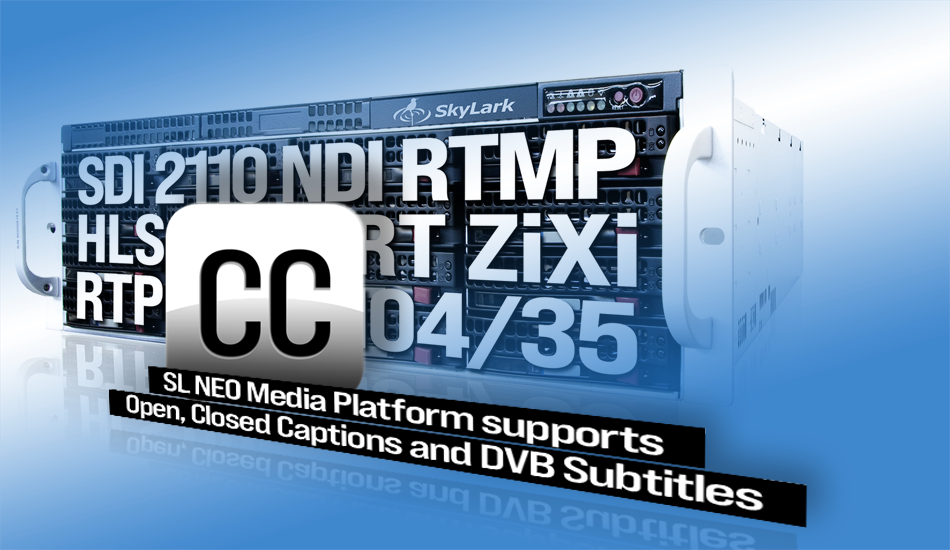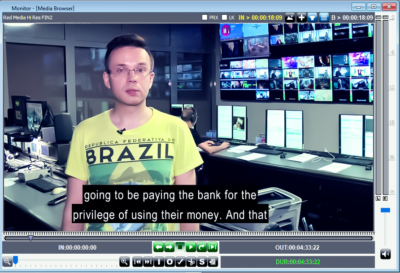SL NEO Media Platform supports a full range of captioning technologies: Open, Closed Captions and DVB Subtitles
- CEA-608 was developed in the 1970s to carry subtitles and data on NTSC standard definition video. It was encoded as a black and white series of pulses on line 21 of the first video field and line 284 for the second field. Each field allowed two possible subtitle channels, four in total, known as CC1, CC2, CC3, and CC4. The total amount of data that could be transmitted was 960 bits per second.
- CEA-708 was designed to replace 608 for high-definition television broadcasts. 708 actually includes 608 bytes as a compatibility layer for older decoding equipment, but also provides an entirely new, improved captioning system. 708 is digitally transmitted as part of a compressed HD DTV stream. It is allocated ten times as much space, 9600 bits per second, as 608. Like the 608, the meaning of the titles is described in Consumer Electronics Association documents. Packet transmission is described in SMPTE 334−1 (the VANC video package) and as an auxiliary package in SMPTE 334−2.
- OP-42 is a standard definition specification for transmitting titles in PAL systems. It is based on part of the teletext specification that later became WST (World System Teletext).
- World System Teletext is a formalized version of the teletext transmission system that was used to transmit information, subtitles, and news to television sets before the advent of the Internet. This specification is still important, although no longer used directly, as it is the basis for OP-42 and OP-47 / RDD-08.
- OP-47 (known in SMPTE as RDD-08) is the European standard for captioning and closed captioning in HD. It has more features than OP-42 and CEA-608, but not as much as CEA-708 because it is based on a limited specification from the larger WST specification.
- DVB Subtitles — technology of Closed Captioning Distribution by data multiplexing in DVB-ASI or IP MPEG Transport Stream. Up to 4 subtitle streams per DVB service are supported. Subtitle generation is performed in accordance with ETSI EN 300 743 (Digital Video Broadcasting (DVB) Subtitling). Both SD and HD formats are supported.
Captioning in the CIAB and Broadcast Graphics Servers (SL NEO 2000, 3000, 5000 Series)
- Generation of open captions in the output video,
- Generation of teletext pages with closed captions according to the specifications OP-42 and OP-47. The number of simultaneously displayed lines, and transition between lines are configured for the pages.
- Teletext Pass-through mode. This mode is required for regional insertions or for adding subtitles to an existing teletext transmission.
- Generation of closed captions according to the specifications CEA-608 and CEA-708.
- The encapsulation of teletext packets into DVB-ASI/IP transport stream. Generation of up to 4 DVB IP subtitle streams per DVB service. Default subtitle language, position, font size, type, color and other display parameters are set for the streams.
- Compatible with most common file formats for subtitles: SRT, SMI, TTML, STL. Automatic import of subtitle files when inserting video files into a Media Datatabase.
- An option to dynamically load subtitles files. In this case the reading of subtitles from the external folder is performed by the program channel during preparation for playing each video clip.
- In Live Close Captioning Mode Servers receive data streams generated by FAB and Polistream Live CC Systems.
Captioning in the other SL NEO Series
- Recording Servers (SL NEO 1000 and 6000) supports recording CC data (as part of the ANC data) along with the video, which allows you to log the received captions, view and extract them if necessary.
- Multiscreen Processors (SL NEO 8000 Series) implements CC decoding and visualization to monitor them in SDI and ASI/IP streams. The page number and subtitle parameters are configured for each multiscreen tile.
- Mediastream Processors (SL NEO 9000 Series) supports CC pass-through and Live Close Captions from data streams generated by FAB and Polistream Live CC Systems.
Previewing and editing CC in the SL NEO Client applications
- The Air Manager and Media Connect applications allow on-air operators and iMAM users to view subtitles from media or text files imported into the Media Database, in the File Monitor interface (see photo). File Monitor also displays available closed captions for selected playlist lines.
- The News Cut application provides functionality for creating and editing CC tracks, as well as quick proxy editing with data on Captions tracks. In addition, News Cut supports the extraction of embedded CC data (recorded in parallel with the video stream) as text files.
- The Multiscreen client application allows you to view the input and output streams of SL NEO servers with visible text generated from closed captioning data.
If you have questions or need more detailed information, please contact us
Send a message or request
News

